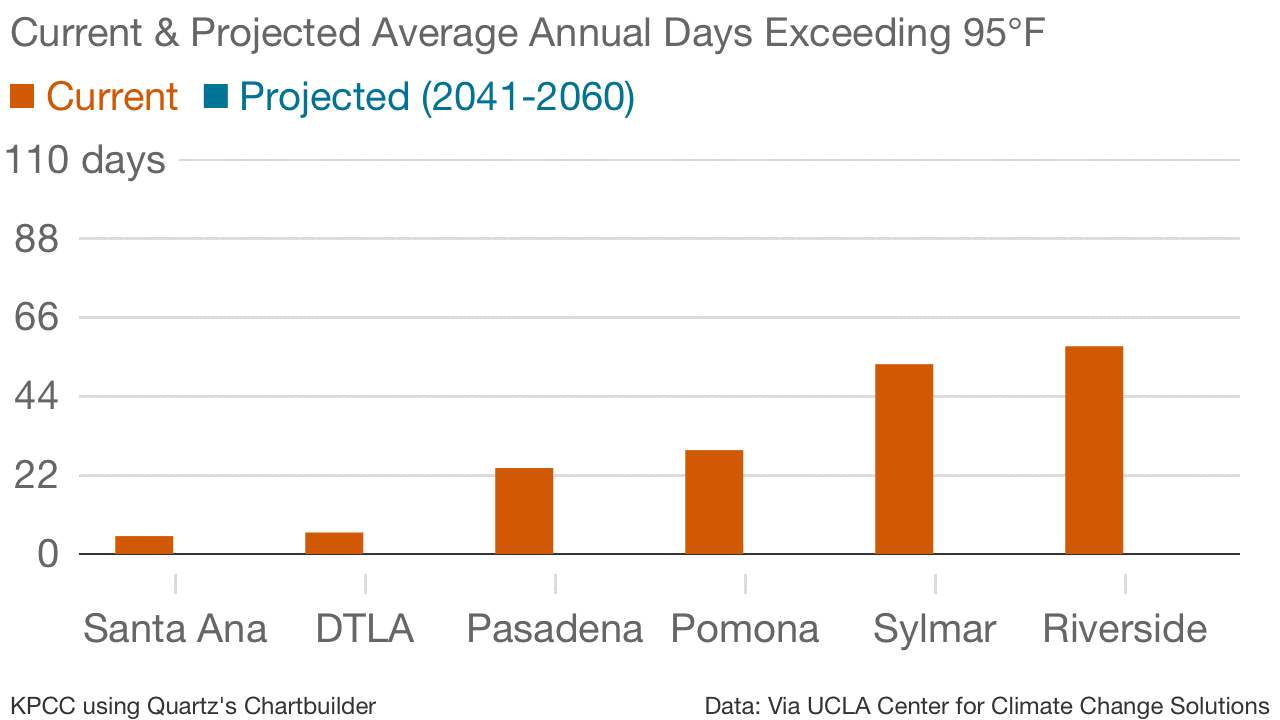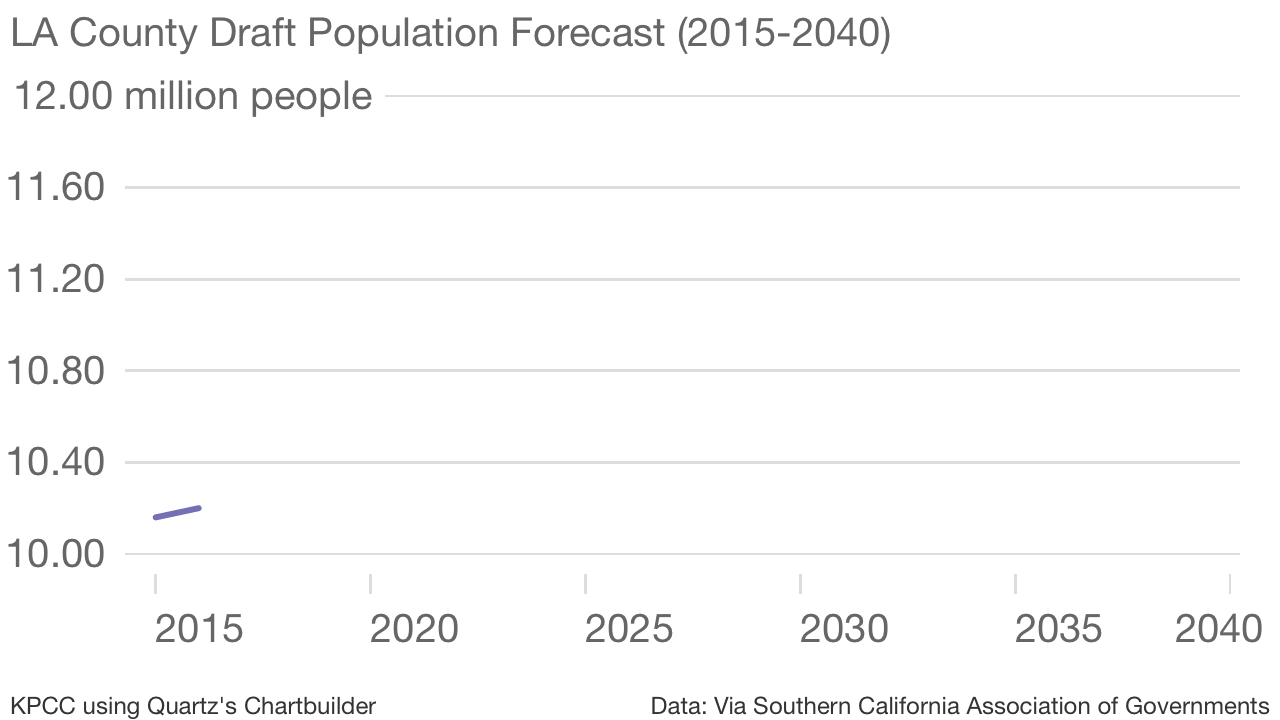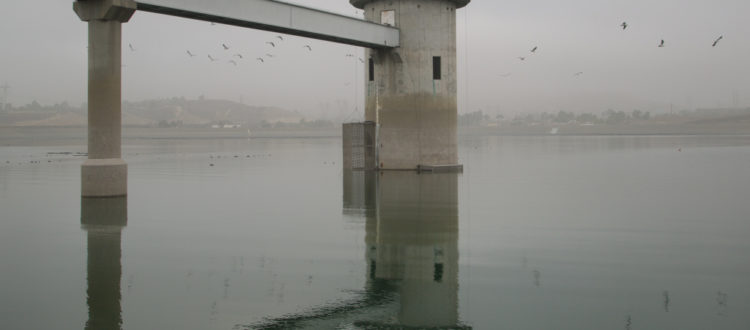Future of Water: How hot, dry and crowded will CA get by 2040?
Published on September 15th, 2015
Sanden Totten
September 14, 2015
Southern California Public Radio (SCPR-89.3 KPCC-FM)
Even if California gets heavy El Niño rains this winter, the current drought has delivered a wake-up call to state leaders. The message? Our current water habits are unsustainable.
Over the coming decades, experts say California's climate will get hotter and drier — all while the state adds millions of new residents.
To help make sense of the challenges to come, KPCC is using the best data available to imagine what California will look like in the year 2040 and how our relationship to water might change as a result.
Over the next five days, we'll explore that question in a series of stories we're calling "The Future of Water."
Today, we take a look at some of the trends that will shape the state over the next 25 years.
By 2040, California will be much hotter — some places hotter than others
California has already warmed 1 to 2°F over the last century, according to Elissa Lynn, a climate scientist with state's Department of Water Resources.
That trend is expected to continue as greenhouse gases trap heat in the atmosphere.
By 2040, Lynn says climate models show California heating up by an average of 4°F. Of course, not every corner of the state will experience the change in the same way.
For instance, the Central Valley is farther from the cooling ocean breeze, so temperatures there could spike as much as 5°F during a typical summer.
On the whole, average temperatures in Southern California are expected to jump 3°F in the winter and 4.5°F in summer.
But as any Californian knows, the weather in one area can be vastly different from the weather in another.
For instance, the number of days 95°F or above — what scientists consider "extreme heat" –will vary depending on the region, said Alex Hall, professor with the UCLA Department of Atmospheric and Oceanic Sciences.
For example, downtown Los Angeles currently experiences about a week of extremely hot weather a year, Hall said.
"By mid-century that increases to about three weeks of extremely hot weather," he said.
Some areas, like the Pasadena, Sylmar and Riverside will see more than a month of additional extreme heat a year.

The average number of extremely hot days per year (defined as days hotter than 95 degrees Fahrenheit) in 1981-2000 (orange bars) and projected for 2041-2060 (blue bars), based on UCLA professor Alex Hall's Climate Change in the Los Angeles Region Project. The future projection is based on data from more than 30 global climate models brought to neighborhood-scale resolution, and it represents a "business as usual" scenario assuming greenhouse gas emissions continue to increase.
California's precipitation will cycle between drought and deluge, and we'll have far less snow
Here's some good news: climate models suggest California will get roughly the same amount of precipitation on average in 2040.
The bad news is that warmer winters will cause more of it to fall as rain instead of snow. That means the snowpack in the Sierra Nevada mountains will shrink, possibly by 30 percent.
The snow pack supplies about third of the water for the entire state, state climate scientist Elissa Lynn said. It typically gives California a steady flow of water in drier months as the snow gradually melts.
"As we lose that snowpack we lose a good portion of our water supply for the spring and summer," Lynn said.
To cope, the state will need to rethink how it stores and distributes moisture from winter storms.
Photos from NASA's Airborne Snow Observatory show a portion of the Sierra snowpack as it forms and melts between March and May 2014. Scientists say peak snowpack could be as much as 30 percent reduced by 2040. Image via Climate Resolve.
Though the result will be less snow, California is expected to see more intense storms punctuated by longer periods of drought.
"So you will have these feast or famine periods where it is completely dry for a very long period of time," Lynn said. "Then it rains for a very long period of time and we can’t capture it and store it."
There are likely to be more wildfires, and more floods
California is no stranger to disaster, and that won't change over the next 25 years. In fact, things may get worse.
UCLA's Alex Hall says summer fires may increase as the region warms up.
"Those are very driven by temperature, so if we warm the landscape we expect an enhancement of fire risk in the summertime."
Floods will also likely increase during wetter periods, as more precipitation falls as rain instead of snow and storms become more intense.
Capturing all that water during rainy years will become crucial not just for water supplies but to help prevent damage to homes and infrastructure as well.
Our traditional water sources will be diminished
As mentioned above, warmer temperatures mean California may lose a good chunk of its snowpack by midcentury, which will have profound implications for water in the state.
The hotter days will also speed evaporation in reservoirs and canals and dry out soils, Hall said.
"If you have drier soils, when the wet season begins again, the water that does fall has to rehydrate those soils," he said.
The ground will essentially take a drink first before any of the rain reaches our lakes and streams, he noted, meaning less water will be available for human consumption.
The bottom line is that California will still get rain, but it will lose more of that moisture as well due to higher temperatures. In 2040, it will be even more important to capture what water we get and use it wisely.
California is projected to grow by 8 million people
According to the US Census Bureau, California was home to nearly 39 million people in 2014.
By 2040, that number is projected to be around 47 million, according to the Demographic Research Unit of the California Department of Finance.
That includes roughly 8 million children under 15, 6 million young adults (age 15-24), 23 million adults (25-64), and 10 million seniors.
The increase will come from a mix of births and people moving to the state from the rest of the U.S. and abroad.
So even as traditional water supplies become less reliable, the state's collective thirst will continue to grow.
Southern California will get much more crowded
Southern California will carry on as a popular place to live in the near future.
In total, the region is expected to grow by 4 million more people, according to researchers with the Southern California Association of Governments, a group that helps cities plan for growth.
"That’s a lot of people," said Hasan Ikhrata, Executive Director of SCAG.
"If you think you have challenges today, traffic and pollution… wait until you have 4 million people."
Los Angeles County currently has about 10 million people and will add another 1 million over the next quarter century.

Ikhrata said L.A. is already crowded, and the population increase means denser neighborhoods will be the norm across much of the region.
"People will not recognize it," he added. "The change is happening at a much faster rate than it ever happened before."
All that growth will put a super-sized strain on water supplies. Add that to the loss in snowpack and the extreme heat, and California has a real challenge ahead of it.






